LAW 6001 Taxation Law Case Study: Analyzing Tax Implications
VerifiedAdded on 2022/07/27
|5
|1256
|35
Case Study
AI Summary
This case study analyzes a taxation law scenario, focusing on tax planning and business structure choices for a client named Matt. The analysis includes estimating annual net rental income or loss under two property investment options, considering maintenance costs and tax rates. It also provides an estimate of net capital gain on the sale of the properties, comparing the financial outcomes of each option. The case study further examines different business structures—sole trader, partnership, Australian registered company, and discretionary family trust—assessing their tax implications for Matt and providing a comparative analysis to recommend the most tax-efficient structure. The document also references relevant literature to support the analysis and recommendations.
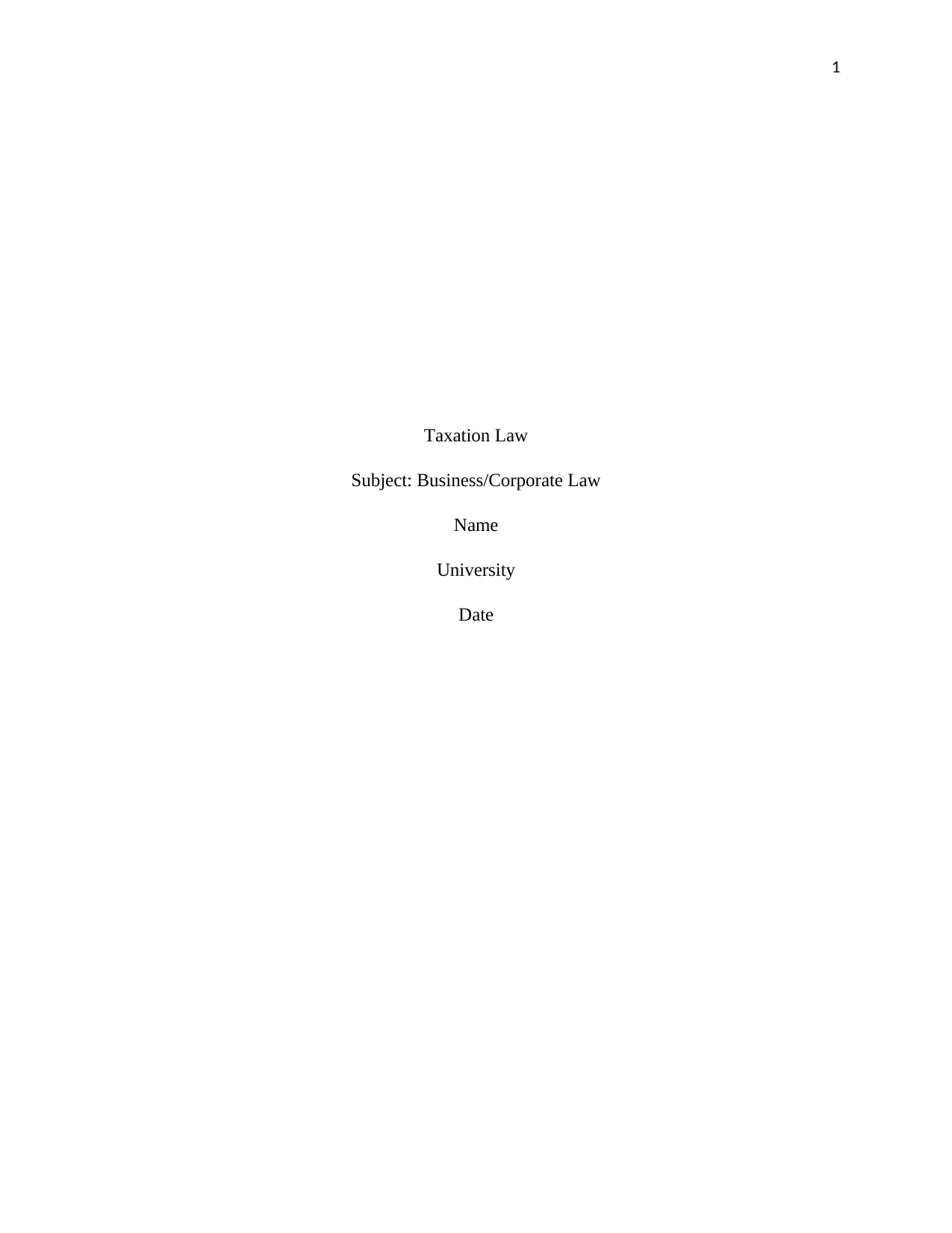
1
Taxation Law
Subject: Business/Corporate Law
Name
University
Date
Taxation Law
Subject: Business/Corporate Law
Name
University
Date
Paraphrase This Document
Need a fresh take? Get an instant paraphrase of this document with our AI Paraphraser
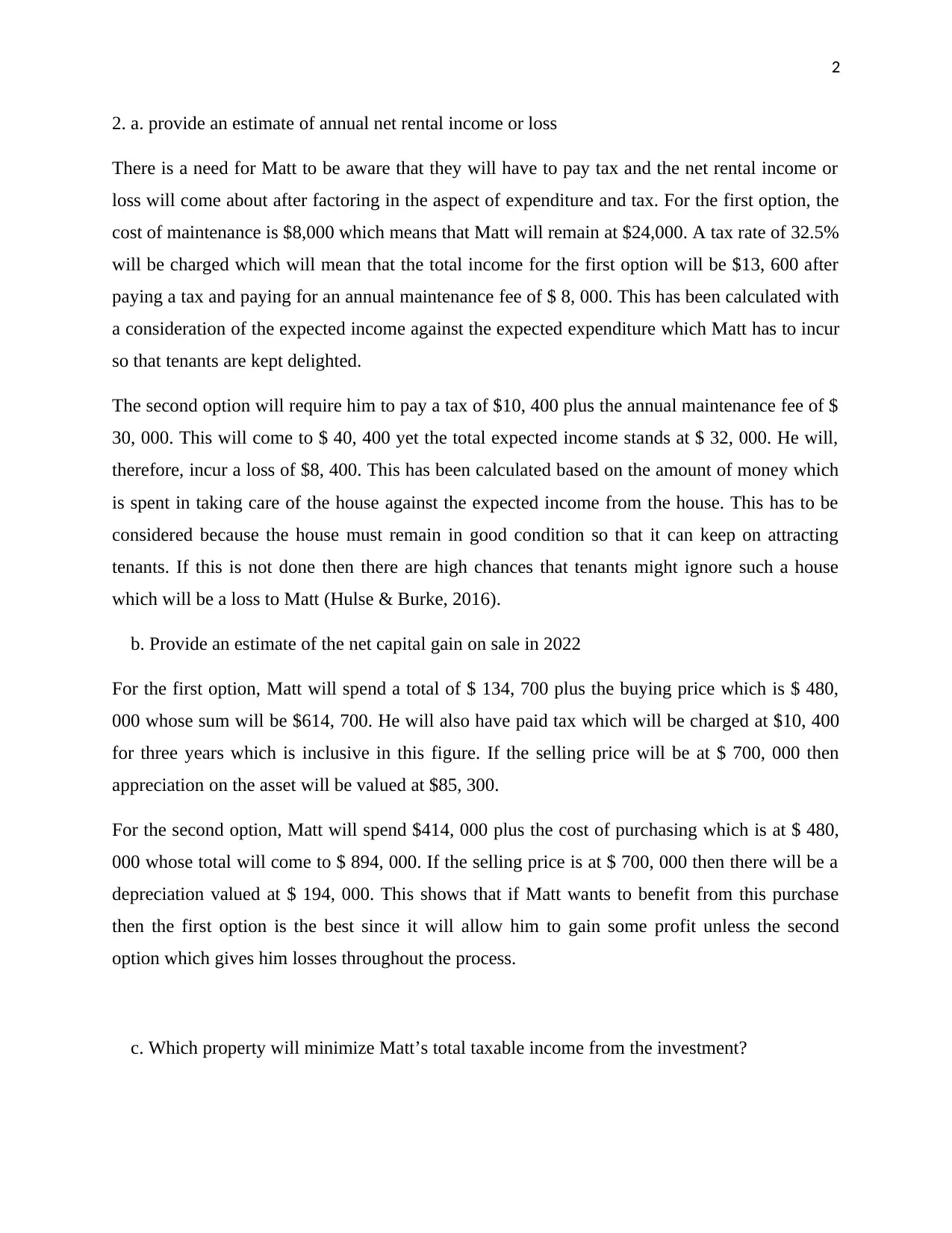
2
2. a. provide an estimate of annual net rental income or loss
There is a need for Matt to be aware that they will have to pay tax and the net rental income or
loss will come about after factoring in the aspect of expenditure and tax. For the first option, the
cost of maintenance is $8,000 which means that Matt will remain at $24,000. A tax rate of 32.5%
will be charged which will mean that the total income for the first option will be $13, 600 after
paying a tax and paying for an annual maintenance fee of $ 8, 000. This has been calculated with
a consideration of the expected income against the expected expenditure which Matt has to incur
so that tenants are kept delighted.
The second option will require him to pay a tax of $10, 400 plus the annual maintenance fee of $
30, 000. This will come to $ 40, 400 yet the total expected income stands at $ 32, 000. He will,
therefore, incur a loss of $8, 400. This has been calculated based on the amount of money which
is spent in taking care of the house against the expected income from the house. This has to be
considered because the house must remain in good condition so that it can keep on attracting
tenants. If this is not done then there are high chances that tenants might ignore such a house
which will be a loss to Matt (Hulse & Burke, 2016).
b. Provide an estimate of the net capital gain on sale in 2022
For the first option, Matt will spend a total of $ 134, 700 plus the buying price which is $ 480,
000 whose sum will be $614, 700. He will also have paid tax which will be charged at $10, 400
for three years which is inclusive in this figure. If the selling price will be at $ 700, 000 then
appreciation on the asset will be valued at $85, 300.
For the second option, Matt will spend $414, 000 plus the cost of purchasing which is at $ 480,
000 whose total will come to $ 894, 000. If the selling price is at $ 700, 000 then there will be a
depreciation valued at $ 194, 000. This shows that if Matt wants to benefit from this purchase
then the first option is the best since it will allow him to gain some profit unless the second
option which gives him losses throughout the process.
c. Which property will minimize Matt’s total taxable income from the investment?
2. a. provide an estimate of annual net rental income or loss
There is a need for Matt to be aware that they will have to pay tax and the net rental income or
loss will come about after factoring in the aspect of expenditure and tax. For the first option, the
cost of maintenance is $8,000 which means that Matt will remain at $24,000. A tax rate of 32.5%
will be charged which will mean that the total income for the first option will be $13, 600 after
paying a tax and paying for an annual maintenance fee of $ 8, 000. This has been calculated with
a consideration of the expected income against the expected expenditure which Matt has to incur
so that tenants are kept delighted.
The second option will require him to pay a tax of $10, 400 plus the annual maintenance fee of $
30, 000. This will come to $ 40, 400 yet the total expected income stands at $ 32, 000. He will,
therefore, incur a loss of $8, 400. This has been calculated based on the amount of money which
is spent in taking care of the house against the expected income from the house. This has to be
considered because the house must remain in good condition so that it can keep on attracting
tenants. If this is not done then there are high chances that tenants might ignore such a house
which will be a loss to Matt (Hulse & Burke, 2016).
b. Provide an estimate of the net capital gain on sale in 2022
For the first option, Matt will spend a total of $ 134, 700 plus the buying price which is $ 480,
000 whose sum will be $614, 700. He will also have paid tax which will be charged at $10, 400
for three years which is inclusive in this figure. If the selling price will be at $ 700, 000 then
appreciation on the asset will be valued at $85, 300.
For the second option, Matt will spend $414, 000 plus the cost of purchasing which is at $ 480,
000 whose total will come to $ 894, 000. If the selling price is at $ 700, 000 then there will be a
depreciation valued at $ 194, 000. This shows that if Matt wants to benefit from this purchase
then the first option is the best since it will allow him to gain some profit unless the second
option which gives him losses throughout the process.
c. Which property will minimize Matt’s total taxable income from the investment?
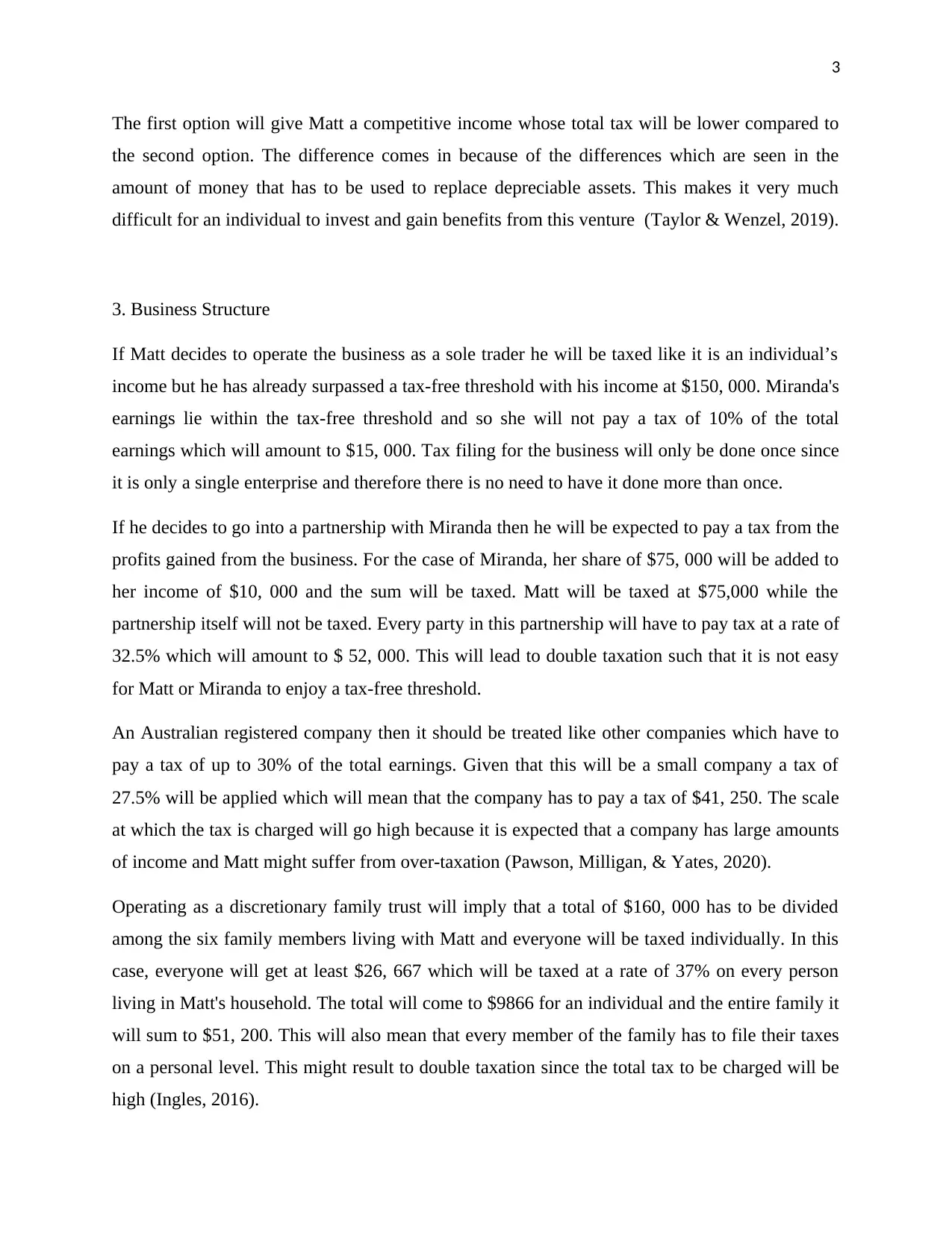
3
The first option will give Matt a competitive income whose total tax will be lower compared to
the second option. The difference comes in because of the differences which are seen in the
amount of money that has to be used to replace depreciable assets. This makes it very much
difficult for an individual to invest and gain benefits from this venture (Taylor & Wenzel, 2019).
3. Business Structure
If Matt decides to operate the business as a sole trader he will be taxed like it is an individual’s
income but he has already surpassed a tax-free threshold with his income at $150, 000. Miranda's
earnings lie within the tax-free threshold and so she will not pay a tax of 10% of the total
earnings which will amount to $15, 000. Tax filing for the business will only be done once since
it is only a single enterprise and therefore there is no need to have it done more than once.
If he decides to go into a partnership with Miranda then he will be expected to pay a tax from the
profits gained from the business. For the case of Miranda, her share of $75, 000 will be added to
her income of $10, 000 and the sum will be taxed. Matt will be taxed at $75,000 while the
partnership itself will not be taxed. Every party in this partnership will have to pay tax at a rate of
32.5% which will amount to $ 52, 000. This will lead to double taxation such that it is not easy
for Matt or Miranda to enjoy a tax-free threshold.
An Australian registered company then it should be treated like other companies which have to
pay a tax of up to 30% of the total earnings. Given that this will be a small company a tax of
27.5% will be applied which will mean that the company has to pay a tax of $41, 250. The scale
at which the tax is charged will go high because it is expected that a company has large amounts
of income and Matt might suffer from over-taxation (Pawson, Milligan, & Yates, 2020).
Operating as a discretionary family trust will imply that a total of $160, 000 has to be divided
among the six family members living with Matt and everyone will be taxed individually. In this
case, everyone will get at least $26, 667 which will be taxed at a rate of 37% on every person
living in Matt's household. The total will come to $9866 for an individual and the entire family it
will sum to $51, 200. This will also mean that every member of the family has to file their taxes
on a personal level. This might result to double taxation since the total tax to be charged will be
high (Ingles, 2016).
The first option will give Matt a competitive income whose total tax will be lower compared to
the second option. The difference comes in because of the differences which are seen in the
amount of money that has to be used to replace depreciable assets. This makes it very much
difficult for an individual to invest and gain benefits from this venture (Taylor & Wenzel, 2019).
3. Business Structure
If Matt decides to operate the business as a sole trader he will be taxed like it is an individual’s
income but he has already surpassed a tax-free threshold with his income at $150, 000. Miranda's
earnings lie within the tax-free threshold and so she will not pay a tax of 10% of the total
earnings which will amount to $15, 000. Tax filing for the business will only be done once since
it is only a single enterprise and therefore there is no need to have it done more than once.
If he decides to go into a partnership with Miranda then he will be expected to pay a tax from the
profits gained from the business. For the case of Miranda, her share of $75, 000 will be added to
her income of $10, 000 and the sum will be taxed. Matt will be taxed at $75,000 while the
partnership itself will not be taxed. Every party in this partnership will have to pay tax at a rate of
32.5% which will amount to $ 52, 000. This will lead to double taxation such that it is not easy
for Matt or Miranda to enjoy a tax-free threshold.
An Australian registered company then it should be treated like other companies which have to
pay a tax of up to 30% of the total earnings. Given that this will be a small company a tax of
27.5% will be applied which will mean that the company has to pay a tax of $41, 250. The scale
at which the tax is charged will go high because it is expected that a company has large amounts
of income and Matt might suffer from over-taxation (Pawson, Milligan, & Yates, 2020).
Operating as a discretionary family trust will imply that a total of $160, 000 has to be divided
among the six family members living with Matt and everyone will be taxed individually. In this
case, everyone will get at least $26, 667 which will be taxed at a rate of 37% on every person
living in Matt's household. The total will come to $9866 for an individual and the entire family it
will sum to $51, 200. This will also mean that every member of the family has to file their taxes
on a personal level. This might result to double taxation since the total tax to be charged will be
high (Ingles, 2016).
⊘ This is a preview!⊘
Do you want full access?
Subscribe today to unlock all pages.

Trusted by 1+ million students worldwide
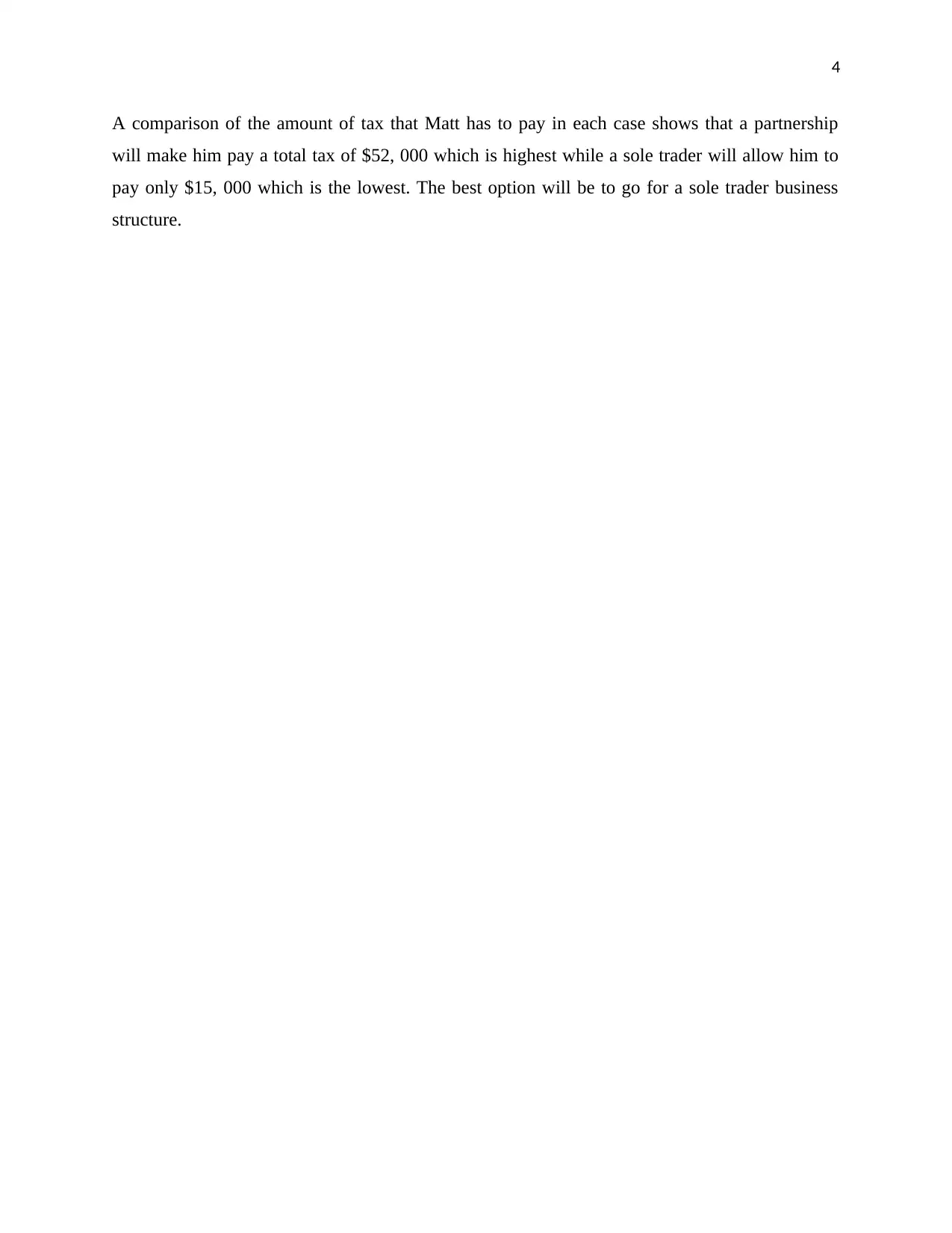
4
A comparison of the amount of tax that Matt has to pay in each case shows that a partnership
will make him pay a total tax of $52, 000 which is highest while a sole trader will allow him to
pay only $15, 000 which is the lowest. The best option will be to go for a sole trader business
structure.
A comparison of the amount of tax that Matt has to pay in each case shows that a partnership
will make him pay a total tax of $52, 000 which is highest while a sole trader will allow him to
pay only $15, 000 which is the lowest. The best option will be to go for a sole trader business
structure.
Paraphrase This Document
Need a fresh take? Get an instant paraphrase of this document with our AI Paraphraser
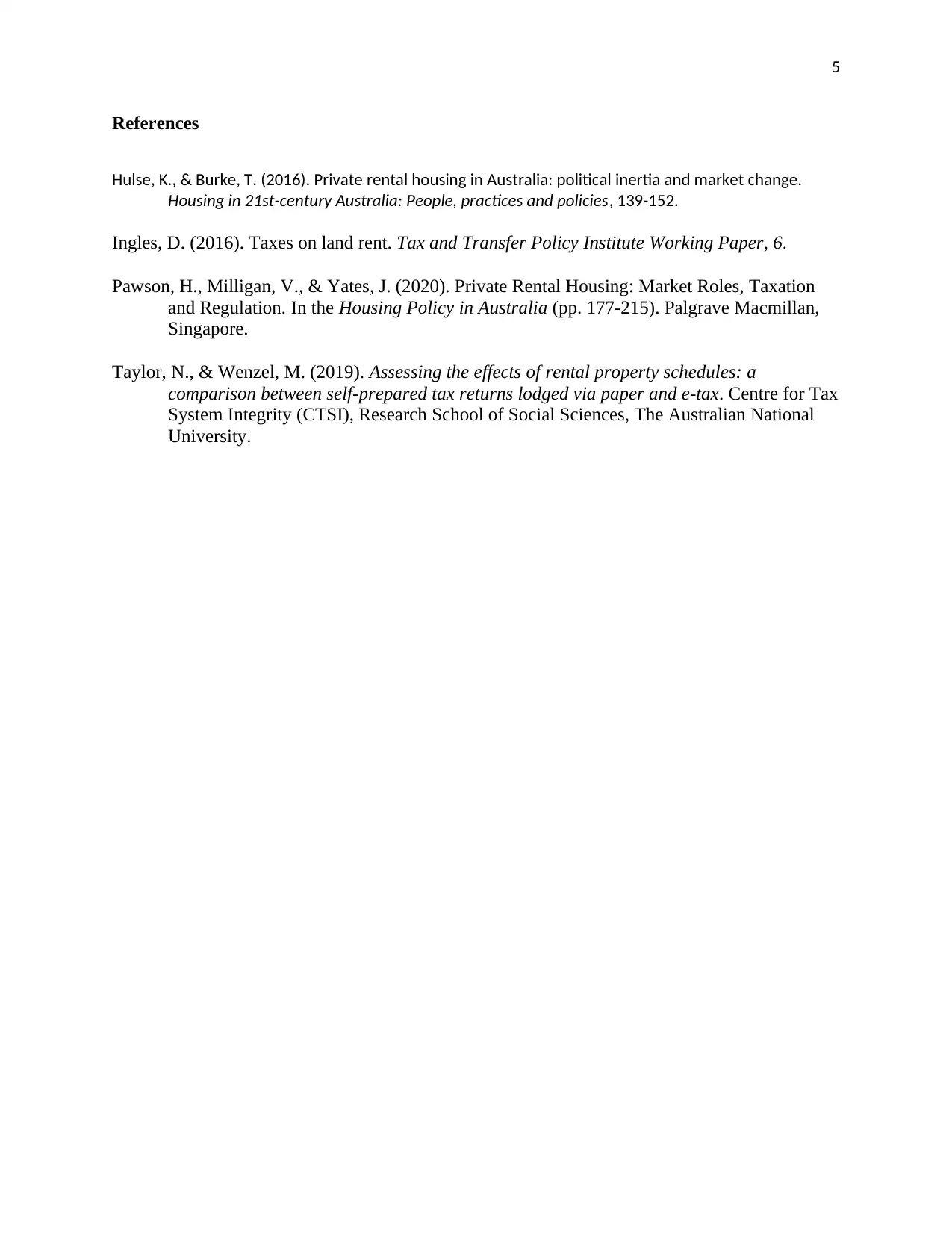
5
References
Hulse, K., & Burke, T. (2016). Private rental housing in Australia: political inertia and market change.
Housing in 21st-century Australia: People, practices and policies, 139-152.
Ingles, D. (2016). Taxes on land rent. Tax and Transfer Policy Institute Working Paper, 6.
Pawson, H., Milligan, V., & Yates, J. (2020). Private Rental Housing: Market Roles, Taxation
and Regulation. In the Housing Policy in Australia (pp. 177-215). Palgrave Macmillan,
Singapore.
Taylor, N., & Wenzel, M. (2019). Assessing the effects of rental property schedules: a
comparison between self-prepared tax returns lodged via paper and e-tax. Centre for Tax
System Integrity (CTSI), Research School of Social Sciences, The Australian National
University.
References
Hulse, K., & Burke, T. (2016). Private rental housing in Australia: political inertia and market change.
Housing in 21st-century Australia: People, practices and policies, 139-152.
Ingles, D. (2016). Taxes on land rent. Tax and Transfer Policy Institute Working Paper, 6.
Pawson, H., Milligan, V., & Yates, J. (2020). Private Rental Housing: Market Roles, Taxation
and Regulation. In the Housing Policy in Australia (pp. 177-215). Palgrave Macmillan,
Singapore.
Taylor, N., & Wenzel, M. (2019). Assessing the effects of rental property schedules: a
comparison between self-prepared tax returns lodged via paper and e-tax. Centre for Tax
System Integrity (CTSI), Research School of Social Sciences, The Australian National
University.
1 out of 5
Your All-in-One AI-Powered Toolkit for Academic Success.
+13062052269
info@desklib.com
Available 24*7 on WhatsApp / Email
![[object Object]](/_next/static/media/star-bottom.7253800d.svg)
Unlock your academic potential
Copyright © 2020–2025 A2Z Services. All Rights Reserved. Developed and managed by ZUCOL.